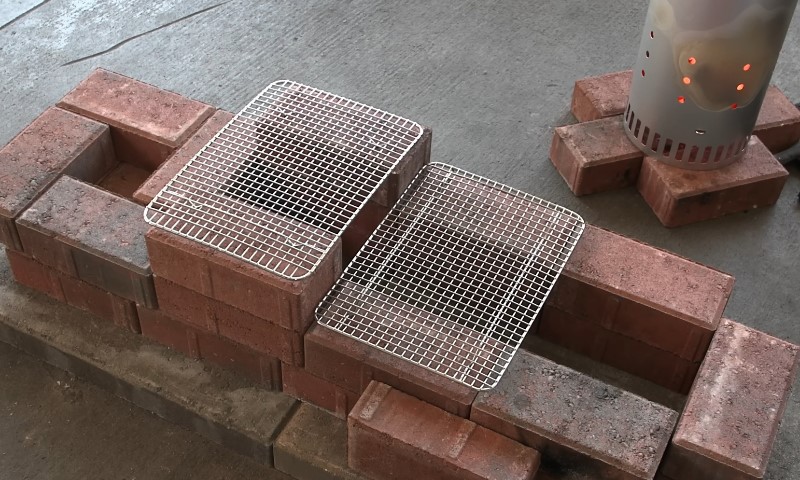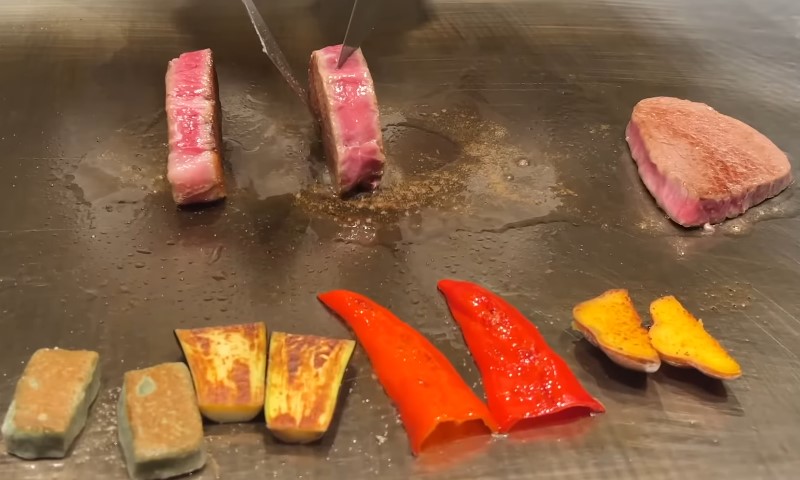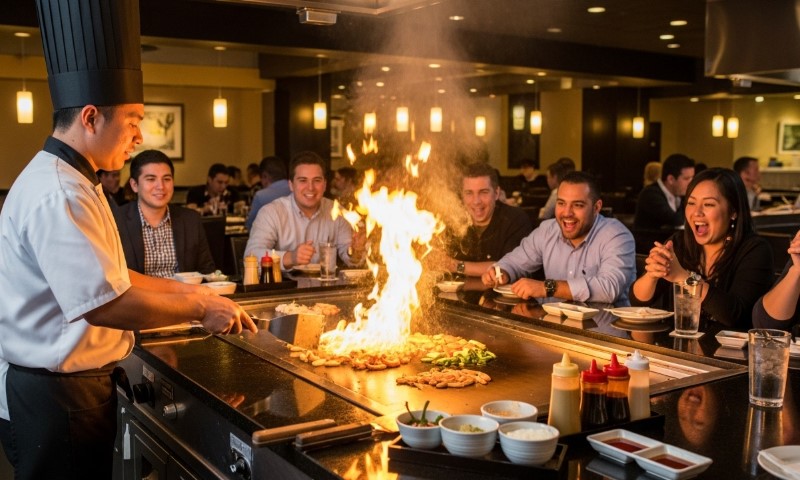If you’ve ever made a dinner reservation for a “hibachi table” and then found yourself watching a chef juggle spatulas and build an onion volcano, you were actually eating teppanyaki. The terms get swapped so often that most people don’t realize they describe two very different things.
One refers to an ancient charcoal heater. The other to a flashy postwar cooking style that turned into a global dining phenomenon.
Let’s unpack what they each mean, where the confusion began, and what’s really going on when the grill in front of you starts to sizzle.
Key Highlights
- Hibachi in Japan means a charcoal fire bowl, not a restaurant grill.
- Teppanyaki is flat-griddle cooking with performance flair.
- U.S. “hibachi restaurants” are actually teppanyaki steakhouses.
-
Hibachi highlights smoke and simplicity, teppanyaki focuses on skill and sear.
Hibachi

What began as a simple household heater in old Japan gradually evolved into a tool for cooking and socializing, setting the stage for the portable charcoal grills many now call hibachi.
What “Hibachi” Means in Japan
The word hibachi (火鉢) literally translates to “fire bowl.” Historically, it referred to a small, open-topped container made of wood, ceramic, or metal. Inside, a layer of ash held glowing charcoal that gave off gentle heat.
Its purpose wasn’t cooking but warming. People used it to heat rooms, warm their hands, or boil tea water in drafty Japanese homes.
Traditional hibachi were beautifully made, sometimes lacquered, sometimes bronze, sometimes painted clay.
They appeared as early as the Heian period, more than a thousand years ago. Picture a family sitting on tatami mats around a low brazier in winter, the faint glow of charcoal lighting the room. That’s the true origin of hibachi.
Key Characteristics of the Original Hibachi
- Small, open-top container
- Filled with ash and charcoal
- Used indoors for warmth or light cooking
- Crafted from wood, ceramic, or metal
- Functioned as a household heating piece, not a grill
Over time, some hibachi were adapted for simple cooking, grilling fish, toasting rice crackers, or boiling tea kettles, but always in a limited, homey context.
Modern “Hibachi Grills” and the Role of Shichirin

In modern Japan, the small charcoal grills sold in stores or used for yakitori are not really hibachi. They’re called shichirin (七輪).
The shichirin is a compact outdoor grill made from ceramic or diatomite, with a metal grate and an adjustable vent. It burns charcoal intensely and is perfect for cooking small cuts of meat or seafood.
So, in Japan today:
- Hibachi = fire bowl, mainly for heat
- Shichirin = small charcoal grill, used for cooking
In Western markets, however, the word “hibachi” has been loosely attached to both the traditional heater and the shichirin-style grill.
Over time, English speakers began using “hibachi” to describe almost any Japanese-style grill. That marketing shortcut blurred the meaning completely.
Teppanyaki

Teppanyaki turns cooking into a performance. Chefs prepare meats, seafood, and vegetables on a large flat iron plate right before guests, blending precision grilling with a touch of theater.
The Literal Meaning
Teppanyaki (鉄板焼き) combines two words:
- Teppan = iron plate
- Yaki = grilled or pan-fried
It simply means cooking on an iron griddle. In practice, teppanyaki refers to a lively restaurant style where chefs prepare food directly on a large, flat, heated steel plate, usually right in front of diners.
How Teppanyaki Started
Teppanyaki is a modern creation, born in 1945 at a restaurant called Misono in Kobe. After World War II, the owners began serving Western-style steak and vegetables cooked on an iron plate at guests’ tables.
The showmanship grew naturally, chefs flipping shrimp, cracking eggs midair, and stacking onions into volcanoes of flame.
At first, Japanese locals saw it as a novelty, something meant to amuse tourists. But American visitors loved the performance and brought that enthusiasm home.
The American Boom
Teppanyaki exploded internationally thanks to one man: Rocky Aoki, founder of Benihana. In 1964, Aoki opened his first New York restaurant, where chefs cooked steak, seafood, and rice with acrobat-like flair on flat grills.
That single innovation, combining dinner with performance, reshaped Japanese cuisine abroad. The word “hibachi” became shorthand for the whole spectacle because it sounded catchy and familiar. Menus, advertisements, and even home grill packaging started calling everything “hibachi.”
The term stuck. Today, if someone in the U.S. says, “Let’s go to a hibachi place,” what they actually mean is a teppanyaki steakhouse.
The Real Difference
@extrariceverynice Hibachi VS Teppanyaki 🤔
Here’s where the confusion clears up. The two may share heat and metal, but they’re built on entirely different tools, fuels, and cooking styles.
Cooking Surface
| Feature | Hibachi / Shichirin | Teppanyaki |
| Cooking surface | Open grate over charcoal | Solid flat steel plate |
| Heat source | Charcoal | Gas or electric |
| Scale | Small, personal grill | Large table-sized griddle |
| Primary use | Grilling skewers or small cuts | Full meal preparation in front of guests |
Hibachi (or shichirin) grills food directly over an open flame. Teppanyaki uses a solid metal plate that transfers heat evenly for searing, stir-frying, and steaming. One is smoky and rustic. The other is clean, sizzling, and theatrical.
Cooking Technique and Flavor
Charcoal hibachi grilling gives food a strong smoky aroma. The direct radiant heat chars the surface and locks in flavor.
Cooks typically season lightly, just salt, soy sauce, or a squeeze of citrus, to highlight the natural taste of the meat or fish.
Teppanyaki works differently. The chef controls the temperature precisely, often dividing the plate into hot and warm zones. Oil and butter replace smoke. The taste comes from browning, sauce blends, and layered textures: crispy on the outside, tender inside.
In a typical teppanyaki dinner, a chef might:
- Sear shrimp in garlic butter
- Fry rice with soy and egg
- Steam vegetables under a metal dome
- Slice and serve steak to each guest
Atmosphere
A true hibachi experience in Japan is quiet and personal. You might find one at a traditional inn, where guests grill skewers themselves over a small brazier. The pleasure lies in conversation and aroma, not in spectacle.
Teppanyaki, especially in the West, is built around the show. Guests gather in groups, the chef greets them with a wide grin, and within minutes knives are flying. It’s part cooking, part entertainment, and part communal celebration.
Why Americans Call Teppanyaki “Hibachi”
View this post on Instagram
The vocabulary mix-up likely started in the 1960s when Japanese-style restaurants were first opening abroad. English-speaking diners were already familiar with the term “hibachi” from imported charcoal grills sold in hardware stores. The actual word “teppanyaki” was harder to pronounce, so restaurants leaned on the more recognizable one.
Over time, menus and advertisements cemented the confusion. By the 1980s, “hibachi” in American English no longer meant a fire bowl; it meant a restaurant with chefs tossing shrimp tails into their hats.
Even today, major chains acknowledge the issue. Benihana’s own materials clarify that they serve teppanyaki, not hibachi. But the nickname stuck so deeply that it’s now part of pop culture.
So, to summarize:
- In Japan: Hibachi = brazier or heater; Teppanyaki = flat-griddle cooking.
- In the U.S.: Hibachi = restaurant experience with flat-grill show cooking (actually teppanyaki).
What You Actually Eat

When you sit down at a so-called hibachi or teppanyaki table, the menu tells the real story. What’s cooked, how it’s seasoned, and even how it’s served reveal whether you’re eating from a charcoal grill or a flat steel plate.
Hibachi / Shichirin Dishes
Small charcoal grills in Japan are ideal for foods that cook quickly:
- Chicken, beef, or pork skewers ( yakitori , kushiyaki )
- Shellfish like scallops or prawns
- Thin-sliced beef or pork belly
- Vegetables such as mushrooms, onions, or peppers
Cooking is done in small batches, shared straight from the grill. Sauces are minimal: soy, ponzu, or a touch of miso, to let the charcoal flavor shine.
Teppanyaki Dishes
A teppanyaki dinner, particularly in Western steakhouses, unfolds as a full course meal. Common menu items include:
- Steak cuts like filet mignon, sirloin, or ribeye
- Shrimp, scallops, chicken, or lobster
- Fried or garlic rice
- Mixed vegetables (zucchini, onion, bean sprouts, carrots)
- Noodles such as yakisoba
- Sauces: ginger, mustard, sesame, or soy-garlic blends
The chef typically serves soup and salad first, then cooks mains and sides sequentially at the grill. Watching the ingredients transform in front of you is part of the fun.
Safety, Ventilation, and Home Versions

Cooking with fire or high heat always raises practical concerns. Whether you’re using charcoal, gas, or electricity, safety and ventilation determine where and how each grill type can be used, especially at home.
Traditional Hibachi Indoors
Old Japanese homes were drafty, so burning charcoal indoors wasn’t as dangerous as it would be in a modern airtight house.
Today, enclosed charcoal use is a carbon-monoxide risk. Antique hibachi are now sold mainly as decorative pieces or for tea ceremonies rather than as practical heaters.
Teppanyaki Ventilation
Teppanyaki restaurants rely on large hoods above each grill. They pull away smoke, oil, and gas fumes just like commercial kitchen exhausts.
That’s why, even with multiple teppans running, the air remains clear enough for guests to sit close.
Modern Consumer Equipment
- “Hibachi grills” sold in American stores are outdoor charcoal units. They should never be used inside.
- Teppanyaki-style electric griddles are designed for indoor home cooking. They use flat non-stick plates and mimic the restaurant experience safely, minus the fire.
For home cooks, an electric teppanyaki grill can recreate much of the fun, sizzling vegetables, eggs, and thin meat slices, without ventilation concerns.
Cultural Role and Symbolism

Both hibachi and teppanyaki carry meanings that go far beyond cooking. One reflects Japan’s domestic past, while the other symbolizes its global influence on dining culture.
Hibachi as a Cultural Artifact
In Japan, antique hibachi are now pieces of cultural heritage. Museums display them as reminders of life before central heating. Collectors appreciate their craftsmanship, the carved wood, lacquer finishes, and bronze ornamentation.
They still appear in traditional inns, sometimes repurposed as tables or decor, keeping a link to that era when the family hearth was a literal bowl of fire.
Teppanyaki as Global “Eatertainment”
Teppanyaki, on the other hand, evolved into a worldwide dining format. Chains like Benihana turned it into a spectacle that bridges cultures. The appeal goes beyond the food: it’s the shared laughter, the theatrical skill, the rhythm of metal on metal.
Restaurants have even adapted the concept for faster modern life. Lunch-hour versions shorten the show to forty-five minutes, while upscale versions feature wagyu beef, lobster, and premium sake pairings.
The teppan table has become one of Japan’s most successful cultural exports, shaping what the world thinks of “Japanese dining,” even if the term hibachi is technically the wrong word for it.
Quick Comparison Table
| Aspect | Hibachi (Traditional or Shichirin Style) | Teppanyaki |
| Literal meaning | “Fire bowl” | “Iron plate grilled” |
| Equipment | Small charcoal brazier or tabletop grill with open grate | Large flat steel plate, gas or electric |
| Historical use | Heating, light cooking | Restaurant show cooking |
| Fuel | Charcoal | Gas or electric |
| Flavor | Smoky, charcoal-grilled | Clean sear, buttery sauces |
| Scale | Small and intimate | Large and social |
| Setting | Home or small izakaya | Restaurant with group seating |
| Western label | Often misused as “hibachi grill” | Marketed as “hibachi” in U.S. steakhouses |
Using the Terms Correctly
If you want to speak accurately:
- Say “hibachi” when referring to a traditional Japanese charcoal brazier or a compact tabletop grill, especially in a domestic or outdoor context.
- Say “teppanyaki” when describing chefs cooking full meals on a flat iron griddle in front of guests.
When you book a “hibachi table” at a restaurant in the U.S., you’re nearly always signing up for a teppanyaki show: griddled steak, garlic rice, and a bit of spectacle. And that’s perfectly fine, as long as you know the distinction.
Final Thoughts
The confusion between hibachi and teppanyaki says more about cultural translation than about cooking itself. One word traveled from ancient Japan as a symbol of warmth and hospitality. The other emerged from postwar Kobe and spread across the globe as an art form of dining theater.
Both represent craftsmanship and connection, just in different ways. One glows quietly beneath ash. The other sparks across a steel plate before a cheering crowd.
Whichever you prefer, knowing the difference helps you appreciate both – the old fire bowl and the modern iron plate, as part of the same long story of Japanese ingenuity around heat, food, and people sharing a meal together.

